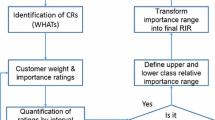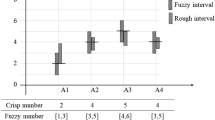Abstract
Product service systems (PSS) have led global manufacturers to change from providing product only to offering both product and its services as a whole. The existing decision-making methods have difficulties in evaluating design alternatives systematically during PSS conceptual design process involving cognition vagueness and related complex factors. A new systematic decision-making method is developed for judging these alternatives. PSS is divided into multiple-modules associated with function characteristics and then evaluated by using the outputs of parallel houses of quality (HoQs). HoQs can efficiently deal with customer requirements and the relationships between product and service. A variable precision rough set-based approach is proposed to evaluate these alternatives, which can flexibly handle subjectivity and vagueness during the decision-making process. An optimizing model of least squares model is used to integrate individual judgments into a consensus group judgment. A non-deterministic ranking method is developed to identify optimal alternative based on the final judgments which are obtained by using a rough weighted geometric mean method. The proposed method is validated through a real-world case study for a horizontal directional drilling machine.





Similar content being viewed by others
References
Atanassov, K., & Gargov, G. (1989). Interval valued intuitionistic fuzzy sets. Fuzzy Sets and Systems, 31, 343–349.
Aurich, J. C., Fuchs, C., & Wagenknecht, C. (2006). Life cycle oriented design of technical product service systems. Journal of Cleaner Production, 14(17), 1480–1494.
Ayağ, Z., & Ozdemir, R. G. (2007). An analytic network process-based approach to concept evaluation in a new product development environment. Journal of Engineering Design, 18(3), 209–226.
Baines, T. S., Lightfoot, H. W., Evans, S., et al. (2007). State-of-the-art in product-service systems. Proceedings of the Institution of Mechanical Engineers, Part B: Journal Engineering Manufacture, 221(10), 1543–1552.
Baxter, D., Roy, R., Doultsinou, A., et al. (2009). A knowledge management framework to support product-service systems design. International Journal of Computer Integrated Manufacturing, 22(12), 1073–1088.
Bordogna, G., Fedrizzi, M., & Pasi, G. (1997). A linguistic modeling of consensus in group decision making based on OWA operators. IEEE Transactions on Systems, Man and Cybernetics-Part A: Systems and Humans, 27, 126–132.
Büyüközkan, G., Arsenyan, J., & Ruan, D. (2012). Logistics tool selection with two-phase fuzzy multi criteria decision making: A case study for personal digital assistant selection. Expert Systems with Applications, 39, 142–153.
Büyüközkan, G., & Çifçi, G. (2013). An integrated QFD framework with multiple formatted and incomplete preferences: A sustainable supply chain application. Applied Soft Computing, 13, 3931–3941.
Cavalieri, S., & Pezzotta, G. (2012). Product-service systems engineering: State of the art and research challenges. Computers in Industry, 63(4), 349–360.
Chen, D. P., Chu, X. N., Sun, X. W., et al. (2014). A new product service system concept evaluation approach based on Information Axiom in a fuzzy-stochastic environment. International Journal of Computer Integrated Manufacturing,. doi:10.1080/0951192x.2014.961550.
Garetti, M., Rosa, P., & Terzi, S. (2012). Life cycle simulation for the design of product-service systems. Computers in Industry, 63(4), 361–369.
Herrera, F., Herrera-Viedma, E., & Martínez, L. (2000). A fusion approach for managing multi-granularity linguistic term sets in decision-making. Fuzzy Sets and Systems, 114, 43–58.
Huang, S. X., Zeang, S., Fan, Y. S., et al. (2011). Optimal service selection and composition for service-oriented manufacturing network. International Journal of Computer Integrated Manufacturing, 24(5), 416–430.
Jin, Y. C. (2003). Advanced fuzzy systems design and applications. London: Springer.
Komoto, H., & Tomiyama, T. (2009). Systematic generation of PSS concepts using a service CAD tool. In T. Sakao & M. Lindahl (Eds.), Introduction to product/service-system design. London: Springer.
Krishnan, K., & Ulrich, K. T. (2001). Product development decisions: A review of the literature. Management Science, 47(1), 1–21.
Kuo, M. S., Tzeng, G. H., & Huang, W. C. (2007). Group decision-making based on concepts of ideal and anti-ideal points in a fuzzy environment. Mathematical and Computer Modelling, 45, 324–339.
Kuo, T. C., & Wang, M. L. (2012). The optimization of maintenance service levels to support the product service system. International Journal of Production Research, 50(23), 6691–6708.
Li, H., Ji, Y. J., Gu, X. J., Qi, G. N., et al. (2012). Module partition process model and method of integrated service product. Computers in Industry, 63(4), 298–308.
Lindahl, M., Sundin, E., & Shimomura, Y., et al. (2006). An interactive design model for service engineering of functional sales offers. In Proceedings of the international design conference, Dubrovnik, Croatia.
Long, H. J., Wang, L. Y., Shen, J., et al. (2013). Product service system configuration based on support vector machine considering customer perception. International Journal of Production Research, 51(18), 5450–5468.
Mannweiler, C., & Aurich J. C., (2011). Customer oriented configuration of product-service systems. Function thinking for value creation. In Proceedings of the 3rd CIRP international conference on industrial product service systems, May 5–6 (pp. 81–86). Braunschweig, Germany
Meier, H., Roy, R., & Seliger, G. (2010). Industrial product-service systems-IPS2. CIRP Annals: Manufacturing Technology, 59(2), 607–627.
Mont, O. (2002). Clarifying the concept of product-service system. Journal of Cleaner Production, 10(3), 237–245.
Pahl, M. L., & Beitz, W. (1996). Engineering design: A systematic approach. London: Springer.
Pawlak, Z. (1982). Rough sets. International Journal of Computer Information Science, 11(5), 341–356.
Sakao, T., & Shimomura, Y. (2007). Service engineering: A novel engineering discipline for producers to increase value combining service and product. Journal of Cleaner Production, 15(6), 590–604.
Sakao, T., Shimomura, Y., Sundin, E., & Comstock, M. (2009). Modeling design objects in CAD system for Service/Product Engineering. Computer-Aided Design, 41(3), 197–213.
Song, W. Y., Ming, X. G., Han, Y., et al. (2013). A rough set approach for evaluating vague customer requirement of industrial product-service system. International Journal of Production Research, 51(22), 6681–6701.
Sun, H. B., Wang, Z., Zhang, Y. F., et al. (2012). Evaluation method of product-service performance. International Journal of Computer Integrated Manufacturing, 20(5), 150–157.
Sundin, E., Lindahl, M., & Comstock, M., et al. (2007). Integrated product and service engineering enabling mass customization. In Proceedings of 19th international conference on production research, Santiago.
Wang, P. P., Ming, X. G., et al. (2011). Modular development of product service systems. Concurrent Engineering: Research and Applications, 19(1), 85–96.
Wang, Y. M., Elhag, T. M. S., & Hua, Z. S. (2006). A modified fuzzy logarithmic least squares method for fuzzy analytic hierarchy process. Fuzzy Sets and Systems, 157, 3055–3071.
Yager, R. R. (1988). On ordered weighted averaging aggregation operators in multicriteria decision-making. IEEE Transaction on Systems, Man and Cybemetics, 18(1), 183–190.
Yoon, B., Kim, S., & Rhee, J. (2012). An evaluation method for designing a new product-service system. Expert Systems with Applications, 39(3), 3100–3108.
Zhai, L. Y., Khoo, L. P., & Zhong, Z. W. (2009). A rough set based QFD approach to the management of imprecise design information in product development. Advanced Engineering Informatics, 23(2), 222–228.
Zhang, D. M., Hu, D. C., Xu, Y. C., et al. (2012). A framework for design knowledge management and reuse for product-service systems in construction machinery industry. Computers in Industry, 63(4), 328–337.
Zhang, Z. F., & Chu, X. N. (2010). A new approach for conceptual design of product & maintenance. International Journal of Computer Integrated Manufacturing, 23(7), 603–618.
Acknowledgements
The project was supported by National Natural Science Foundation of China (Nos. 51205242, 71101084, 51405281) and Shanghai Science and Technology Innovation Action Plan (No. 16111106402).
Author information
Authors and Affiliations
Corresponding author
Rights and permissions
About this article
Cite this article
Zhang, Z., Xu, D., Ostrosi, E. et al. A systematic decision-making method for evaluating design alternatives of product service system based on variable precision rough set. J Intell Manuf 30, 1895–1909 (2019). https://doi.org/10.1007/s10845-017-1359-6
Received:
Accepted:
Published:
Issue Date:
DOI: https://doi.org/10.1007/s10845-017-1359-6




